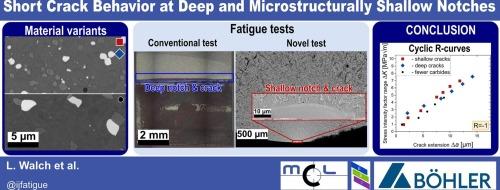短裂纹行为在深和微观结构上浅缺口
IF 6.8
2区 材料科学
Q1 ENGINEERING, MECHANICAL
引用次数: 0
摘要
通常,疲劳裂纹扩展的实验特征是使用裂纹从深的、穿过试样宽度的缺口发出,这些缺口平均了沿裂纹前沿的许多微观结构特征上的裂纹扩展行为。在大多数工具中,如此深而宽的裂缝并不能准确地代表现实,因为裂缝通常是由微小的微观结构特征产生的,例如表面的碳化物或浅缺口。因此,常规获得的疲劳数据在与应用相关的短裂纹上的普遍适用性是不确定的。此外,通过对局部性能进行平均,可以隐藏微观组织特征对扩展行为的影响。目前的工作解决了在深缺口上获得的短裂纹疲劳数据有效性的开放性问题,该数据使用一种新方法来监测与应用相关的微结构小裂纹和浅裂纹的扩展。该技术可以使用交流电位降法在少量微结构特征附近原位测量由应用相关尺寸的人工缺陷产生的微结构小裂纹。通过聚焦离子束铣削引入微米大小的半椭圆缺口的实例,对该技术进行了验证。测量电位的增加与所用材料的疲劳裂纹扩展、信号电流和信号频率组合有关。微观结构上小裂纹的短裂纹扩展行为与单边缺口弯曲试样的短裂纹扩展行为相似。结果表明,在物理上短但宏观上深的裂纹上获得的短裂纹扩展行为也适用于与应用相关的高强度材料缺陷尺寸。本文章由计算机程序翻译,如有差异,请以英文原文为准。

Short crack behavior at deep and microstructurally shallow notches
Usually, fatigue crack propagation is experimentally characterized using cracks emanating from deep, through-specimen-width notches that average the crack’s propagation behavior over many microstructural features along the crack front. Such a deep and wide crack does not accurately represent the reality in most tools, where cracks typically emanate from small microstructural features, such as carbides or shallow notches at the surface. Therefore, the general applicability of conventionally obtained fatigue data on application-relevant short cracks was uncertain. Furthermore, by averaging local properties, the effect of microstructural features on the propagation behavior remained hidden. The current work addresses the open question of the validity of short crack fatigue data obtained on deep notches using a novel method to monitor the propagation of application-relevant, microstructurally small, and shallow cracks. The technique enables in situ measurement of microstructurally small cracks emanating from an artificial defect of application-relevant size near a small number of microstructural features by using the alternating-current potential drop method. The technique is demonstrated on the example of µm-sized semi-elliptical notches introduced via focused ion beam milling. Measured potential increases were correlated to fatigue crack extensions for the utilized material, signal current, and signal frequency combination. The short crack propagation behavior of microstructurally small cracks resembled that observed for short cracks in single-edge notched bending specimens. The results indicate that the short crack propagation behavior obtained on physically short but macroscopically deep cracks is also valid for application-relevant defect sizes for high-strength materials.
求助全文
通过发布文献求助,成功后即可免费获取论文全文。
去求助
来源期刊

International Journal of Fatigue
工程技术-材料科学:综合
CiteScore
10.70
自引率
21.70%
发文量
619
审稿时长
58 days
期刊介绍:
Typical subjects discussed in International Journal of Fatigue address:
Novel fatigue testing and characterization methods (new kinds of fatigue tests, critical evaluation of existing methods, in situ measurement of fatigue degradation, non-contact field measurements)
Multiaxial fatigue and complex loading effects of materials and structures, exploring state-of-the-art concepts in degradation under cyclic loading
Fatigue in the very high cycle regime, including failure mode transitions from surface to subsurface, effects of surface treatment, processing, and loading conditions
Modeling (including degradation processes and related driving forces, multiscale/multi-resolution methods, computational hierarchical and concurrent methods for coupled component and material responses, novel methods for notch root analysis, fracture mechanics, damage mechanics, crack growth kinetics, life prediction and durability, and prediction of stochastic fatigue behavior reflecting microstructure and service conditions)
Models for early stages of fatigue crack formation and growth that explicitly consider microstructure and relevant materials science aspects
Understanding the influence or manufacturing and processing route on fatigue degradation, and embedding this understanding in more predictive schemes for mitigation and design against fatigue
Prognosis and damage state awareness (including sensors, monitoring, methodology, interactive control, accelerated methods, data interpretation)
Applications of technologies associated with fatigue and their implications for structural integrity and reliability. This includes issues related to design, operation and maintenance, i.e., life cycle engineering
Smart materials and structures that can sense and mitigate fatigue degradation
Fatigue of devices and structures at small scales, including effects of process route and surfaces/interfaces.
 求助内容:
求助内容: 应助结果提醒方式:
应助结果提醒方式:


